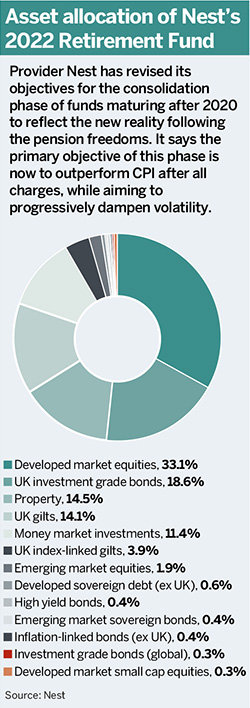DC Investment Quarterly: Schemes are being cautious to ensure any DC design decisions made now are malleable enough to be able to respond to future changes.
However, several expectations regarding how DC schemes would design their investment portfolios are beginning to bear out.
The general theme is around ‘keeping your options open’ to reflect member choice at retirement – but also to be able to adjust scheme design as longer-term trends arise.
 As such, determining hard patterns of behaviour among both schemes and members is still somewhat intractable.
As such, determining hard patterns of behaviour among both schemes and members is still somewhat intractable.
Annabel Duncan, DC client adviser at JPMorgan Asset Management, says short-term member behaviour is unlikely to be a strong indicator of future trends, so a diversified and flexible position is prudent at this stage.
She says DC market flux is making it harder for employers to choose an appropriate default solution for members.
“Plans need to focus on defaults that offer multi-asset flexibility and risk management, to ensure members are properly diversified and best equipped for whatever post-retirement choices they may make,” she says.
Shape of things to come
JPMorgan has revised its derisking strategy so that as members reach their retirement date, the equity weighting is a full 12 percentage points higher at 20 per cent.
In addition, the allocation to real assets has been upped to 10 per cent from 8 per cent to reflect the fact that members remaining invested beyond their retirement date will need exposure to “inflation-aware assets”.
But such adjustments, Duncan says, are not at the expense of the traditional annuity-focused strategies.
“Access to a diversified mix of assets – including allocations to corporate and global government debt, along with equity and liquid alternatives – is actually more correlated to annuities than the typical 15-year gilt portfolio that existed pre April’s changes,” she says.
Alan Swallow, actuary at consultancy Cartwright Group, says a convergence of the Budget changes, the Pensions Regulator’s tightening DC governance and ‘big data’ capabilities mean trustees are not only actively reviewing their investment thinking, but also the use of technology and wider communication strategies.
He says some schemes with large governance budgets are assessing data trends among their members to identify which fund ranges might suit certain cohorts. But Swallow adds the general trend is a leaning towards drawdown.
He said: “We are seeing an increased use of drawdown leading [schemes] to offer more than one lifestyle strategy, with a focus on adding less volatile growth funds and income-generating funds.”
We are seeing an increased use of drawdown leading [schemes] to offer more than one lifestyle strategy, with a focus on adding less volatile growth funds and income generating funds
Alan Swallow, Cartwright Group
Swallow added the types of schemes taking the drawdown route are among small and medium-sized employers with relatively higher contribution levels and DC alternatives to auto-enrolment, looking for proportionate solutions.
But Jonathan Watts-Lay, director at benefits adviser Wealth at Work, says that among schemes that have decided to offer three glidepaths towards cash, annuity and drawdown, some have said that if the member fails to make a choice, they will automatically be defaulted into one of the options.
“However, default into what?,” Watts-Lay says. “I have seen a default which assumes annuity purchase and a default which assumes drawdown. This seems pretty arbitrary to me and potentially dangerous.”
Eye on regulation
The regulator’s code of practice 13 contains requirements on the monitoring and reviewing of default strategies and investment fund performance.
Ian Love, director of business development, UK institutional, at fiduciary manager SEI, says increased regulatory scrutiny on schemes’ investment rationales is also influencing many redesigns.
For members of DC schemes this renewed focus on investments can only be a positive. For trustees, it will increasingly become a matter of balancing their time and resources
Ian Love, SEI
“To comply with the DC code of conduct,” he says, “trustees must now demonstrate why their scheme has the most appropriate fund range, risk profile and default strategy, whilst delivering appropriate levels of performance for the right level of risk and providing members with value for money.”
DC’s previous key focal points have been administration, costs and implementing auto-enrolment, Love says. But the quality of investments and the recognition that good asset allocation is a fundamental driver of member outcomes is leading to a shake-up of scheme design in this regard.
He says: “For members of DC schemes this renewed focus on investments can only be a positive,” but adds: “For trustees, it will increasingly become a matter of balancing their time and resources.”
And in contrast to the ‘resurgence of paternalism’ described elsewhere in the industry, Love says governance requirements could in fact have an adverse effect on employers’ ability to provide a high-quality trust-based DC pension scheme.
He notes many employers could find the cost of meeting the governance and compliance responsibilities overly onerous.
“Furthermore it’s going to become increasingly difficult for DC scheme trustees to keep up with the growing requirements of the DC code,” Love adds.
But is it possible for employers and schemes to manage in this regulatory environment without going down the mastertrust route?
Cartwright’s Swallow says it is about finding the best fit for the scheme size and membership profile.
Smaller schemes should not seek out the most complex or sophisticated strategies and should adopt a “proportionate approach” at an affordable price he says, adding: “Pragmatism over idealism.”














